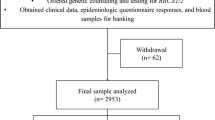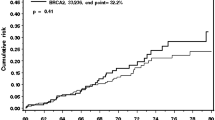Abstract
BRCA1/2 mutations represent approximately 5 % of unselected Chinese women with breast cancer. However, the breast cancer risk of Chinese women with BRCA1/2 mutations is unknown. Therefore, the aim of this study was to estimate the age-specific cumulative risk of breast cancer in Chinese women who carry a BRCA1 or BRCA2 mutation. Our study included 1816 unselected Chinese women with breast cancer and 5549 female first-degree relatives of these probands. All probands were screened for BRCA1/2 mutation. The age-specific cumulative risks of BRCA1/2 carriers were estimated using the kin-cohort study by comparing the history of breast cancer in first-degree female relatives of BRCA1/2 carriers and non-carriers. Among the 1816 probands, 125 BRCA1/2 pathogenic mutations were identified (70 in the BRCA1 gene and 55 in the BRCA2 gene). The incidence of breast cancer in the first-degree female relatives of BRCA1/2 mutation carriers was significantly higher (3.7-fold and 4.4-fold for BRCA1 and BRCA2 mutation carriers, respectively) than in non-carriers. The estimated cumulative risks of breast cancer by age 70 years were 37.9 % [95 % confidence interval (CI) 24.1–54.4 %] for BRCA1 mutation carriers and 36.5 % (95 % CI 26.7–51.8 %) for BRCA2 mutation carriers, respectively. Our study suggests that the breast cancer risk of Chinese women with BRCA1/2 mutations appears to be relatively high by the age of 70. Therefore, genetic counseling, enhanced surveillance, and individual preventive strategies should be provided for Chinese women who carry a BRCA1/2 mutation.

Similar content being viewed by others
References
Miki Y, Swensen J, Shattuck-Eidens D et al (1994) A strong candidate for the breast and ovarian cancer susceptibility gene BRCA1. Science 266(5182):66–71
Wooster R, Neuhausen SL, Mangion J et al (1994) Localization of a breast cancer susceptibility gene, BRCA2, to chromosome 13q12-13. Science 265(5181):2088–2090
Engel C, Fischer C (2015) Breast cancer risks and risk prediction models. Breast Care (Basel) 10(1):7–12. doi:10.1159/000376600
Antoniou A, Pharoah PD, Narod S et al (2003) Average risks of breast and ovarian cancer associated with BRCA1 or BRCA2 mutations detected in case series unselected for family history: a combined analysis of 22 studies. Am J Hum Genet 72(5):1117–1130. doi:10.1086/375033
Chen S, Parmigiani G (2007) Meta-analysis of BRCA1 and BRCA2 penetrance. J Clin Oncol 25(11):1329–1333. doi:10.1200/JCO.2006.09.1066
Easton DF, Ford D, Bishop DT (1995) Breast and ovarian cancer incidence in BRCA1-mutation carriers. Breast cancer linkage consortium. Am J Hum Genet 56(1):265–271
Struewing JP, Hartge P, Wacholder S et al (1997) The risk of cancer associated with specific mutations of BRCA1 and BRCA2 among Ashkenazi Jews. N Engl J Med 336(20):1401–1408. doi:10.1056/NEJM199705153362001
Ford D, Easton DF, Stratton M et al (1998) Genetic heterogeneity and penetrance analysis of the BRCA1 and BRCA2 genes in breast cancer families. The breast cancer linkage consortium. Am J Hum Genet 62(3):676–689
Fodor FH, Weston A, Bleiweiss IJ et al (1998) Frequency and carrier risk associated with common BRCA1 and BRCA2 mutations in Ashkenazi Jewish breast cancer patients. Am J Hum Genet 63(1):45–51. doi:10.1086/301903
Hopper JL, Southey MC, Dite GS et al (1999) Population-based estimate of the average age-specific cumulative risk of breast cancer for a defined set of protein-truncating mutations in BRCA1 and BRCA2. Australian breast cancer family study. Cancer Epidemiol Biomarkers Prev 8(9):741–747
King MC, Marks JH, Mandell JB (2003) Breast and ovarian cancer risks due to inherited mutations in BRCA1 and BRCA2. Science 302(5645):643–646. doi:10.1126/science.1088759
Risch HA, McLaughlin JR, Cole DE et al (2001) Prevalence and penetrance of germline BRCA1 and BRCA2 mutations in a population series of 649 women with ovarian cancer. Am J Hum Genet 68(3):700–710. doi:10.1086/318787
Mavaddat N, Peock S, Frost D et al (2013) Cancer risks for BRCA1 and BRCA2 mutation carriers: results from prospective analysis of EMBRACE. J Natl Cancer Inst 105(11):812–822. doi:10.1093/jnci/djt095
Tryggvadottir L, Sigvaldason H, Olafsdottir GH et al (2006) Population-based study of changing breast cancer risk in Icelandic BRCA2 mutation carriers, 1920–2000. J Natl Cancer Inst 98(2):116–122. doi:10.1093/jnci/djj012
Fackenthal JD, Olopade OI (2007) Breast cancer risk associated with BRCA1 and BRCA2 in diverse populations. Nat Rev Cancer 7(12):937–948. doi:10.1038/nrc2054
Anglian Breast Cancer Study Group (2000) Prevalence and penetrance of BRCA1 and BRCA2 mutations in a population-based series of breast cancer cases. Br J Cancer 83(10):1301–1308. doi:10.1054/bjoc.2000.1407
Antoniou AC, Pharoah PD, Narod S et al (2005) Breast and ovarian cancer risks to carriers of the BRCA1 5382insC and 185delAG and BRCA2 6174delT mutations: a combined analysis of 22 population based studies. J Med Genet 42(7):602–603. doi:10.1136/jmg.2004.024133
Begg CB, Haile RW, Borg A et al (2008) Variation of breast cancer risk among BRCA1/2 carriers. JAMA 299(2):194–201. doi:10.1001/jama.2007.55-a
Evans DG, Shenton A, Woodward E et al (2008) Penetrance estimates for BRCA1 and BRCA2 based on genetic testing in a clinical cancer genetics service setting: risks of breast/ovarian cancer quoted should reflect the cancer burden in the family. BMC Cancer 8:155. doi:10.1186/1471-2407-8-155
Metcalfe K, Lubinski J, Lynch HT et al (2010) Family history of cancer and cancer risks in women with BRCA1 or BRCA2 mutations. J Natl Cancer Inst 102(24):1874–1878. doi:10.1093/jnci/djq443
Antoniou AC, Gayther SA, Stratton JF et al (2000) Risk models for familial ovarian and breast cancer. Genet Epidemiol 18(2):173–190. doi:10.1002/(SICI)1098-2272(200002)18:2<173:AID-GEPI6>3.0.CO;2-R
Park B, Dowty JG, Ahn C et al (2015) Breast cancer risk for Korean women with germline mutations in BRCA1 and BRCA2. Breast Cancer Res Treat 152(3):659–665. doi:10.1007/s10549-015-3495-z
Fan L, Strasser-Weippl K, Li JJ et al (2014) Breast cancer in China. Lancet Oncol 15(7):e279–e289. doi:10.1016/S1470-2045(13)70567-9
Suter NM, Ray RM, Hu YW et al (2004) BRCA1 and BRCA2 mutations in women from Shanghai China. Cancer Epidemiol Biomarkers Prev 13(2):181–189
Li WF, Hu Z, Rao NY et al (2008) The prevalence of BRCA1 and BRCA2 germline mutations in high-risk breast cancer patients of Chinese Han nationality: two recurrent mutations were identified. Breast Cancer Res Treat 110(1):99–109. doi:10.1007/s10549-007-9708-3
Zhang J, Pei R, Pang Z et al (2012) Prevalence and characterization of BRCA1 and BRCA2 germline mutations in Chinese women with familial breast cancer. Breast Cancer Res Treat 132(2):421–428. doi:10.1007/s10549-011-1596-x
Nathanson KL, Wooster R, Weber BL (2001) Breast cancer genetics: what we know and what we need. Nat Med 7(5):552–556. doi:10.1038/87876
Chen W, Pan K, Ouyang T et al (2009) BRCA1 germline mutations and tumor characteristics in Chinese women with familial or early-onset breast cancer. Breast Cancer Res Treat 117(1):55–60. doi:10.1007/s10549-008-0066-6
Kwong A, Shin VY, Ho JC et al (2015) Comprehensive spectrum of BRCA1 and BRCA2 deleterious mutations in breast cancer in Asian countries. J Med Genet. doi:10.1136/jmedgenet-2015-103132
Rebbeck TR, Mitra N, Wan F et al (2015) Association of type and location of BRCA1 and BRCA2 mutations with risk of breast and ovarian cancer. JAMA 313(13):1347–1361. doi:10.1001/jama.2014.5985
Chatterjee N, Wacholder S (2001) A marginal likelihood approach for estimating penetrance from kin-cohort designs. Biometrics 57(1):245–252
Mukherjee B, Delancey JO, Raskin L et al (2012) Risk of non-melanoma cancers in first-degree relatives of CDKN2A mutation carriers. J Natl Cancer Inst 104(12):953–956. doi:10.1093/jnci/djs221
Thorlacius S, Struewing JP, Hartge P et al (1998) Population-based study of risk of breast cancer in carriers of BRCA2 mutation. Lancet 352(9137):1337–1339
Warner E, Foulkes W, Goodwin P et al (1999) Prevalence and penetrance of BRCA1 and BRCA2 gene mutations in unselected Ashkenazi Jewish women with breast cancer. J Natl Cancer Inst 91(14):1241–1247
Risch HA, McLaughlin JR, Cole DE et al (2006) Population BRCA1 and BRCA2 mutation frequencies and cancer penetrances: a kin-cohort study in Ontario, Canada. J Natl Cancer Inst 98(23):1694–1706. doi:10.1093/jnci/djj465
Millikan RC, Hummer AJ, Wolff MS et al (2005) HER2 codon 655 polymorphism and breast cancer: results from kin-cohort and case–control analyses. Breast Cancer Res Treat 89(3):309–312. doi:10.1007/s10549-004-2171-5
Sigurdson AJ, Hauptmann M, Chatterjee N et al (2004) Kin-cohort estimates for familial breast cancer risk in relation to variants in DNA base excision repair, BRCA1 interacting and growth factor genes. BMC Cancer 4:9. doi:10.1186/1471-2407-4-9
Hashemian AH, Hajizadeh E, Kazemnejad A et al (2009) Penetrance of BRCA1/BRCA2 specific gene mutations in Iranian women with breast cancer. Saudi Med J 30(1):41–44
Beijing Municipal People’s Government (2013) Beijing municipal health and population health report. People’s Medical Publishing House, Beijing
Narod SA (2002) Modifiers of risk of hereditary breast and ovarian cancer. Nat Rev Cancer 2(2):113–123. doi:10.1038/nrc726
Begg CB (2002) On the use of familial aggregation in population-based case probands for calculating penetrance. J Natl Cancer Inst 94(16):1221–1226
Ford D, Easton DF, Bishop DT et al (1994) Risks of cancer in BRCA1-mutation carriers. Breast cancer linkage consortium. Lancet 343(8899):692–695
de Bruin MA, Kwong A, Goldstein BA et al (2012) Breast cancer risk factors differ between Asian and white women with BRCA1/2 mutations. Fam Cancer 11(3):429–439. doi:10.1007/s10689-012-9531-9
van der Kolk DM, de Bock GH, Leegte BK et al (2010) Penetrance of breast cancer, ovarian cancer and contralateral breast cancer in BRCA1 and BRCA2 families: high cancer incidence at older age. Breast Cancer Res Treat 124(3):643–651. doi:10.1007/s10549-010-0805-3
Nelson HD, Pappas M, Zakher B et al (2014) Risk assessment, genetic counseling, and genetic testing for BRCA-related cancer in women: a systematic review to update the U.S. preventive services task force recommendation. Ann Intern Med 160(4):255–266. doi:10.7326/M13-1684
Giuliano AE, Boolbol S, Degnim A et al (2007) Society of surgical oncology: position statement on prophylactic mastectomy. Approved by the Society of Surgical Oncology Executive Council, March 2007. Ann Surg Oncol 14(9):2425–2427. doi:10.1245/s10434-007-9447-z
Hartmann LC, Sellers TA, Schaid DJ et al (2001) Efficacy of bilateral prophylactic mastectomy in BRCA1 and BRCA2 gene mutation carriers. J Natl Cancer Inst 93(21):1633–1637
Hartmann LC, Lindor NM (2016) The role of risk-reducing surgery in hereditary breast and ovarian cancer. N Engl J Med 374(5):454–468. doi:10.1056/NEJMra1503523
Vasen HF, Haites NE, Evans DG et al (1998) Current policies for surveillance and management in women at risk of breast and ovarian cancer: a survey among 16 European family cancer clinics. European Familial Breast Cancer Collaborative Group. Eur J Cancer 34(12):1922–1926
Houn F, Helzlsouer KJ, Friedman NB et al (1995) The practice of prophylactic mastectomy: a survey of Maryland surgeons. Am J Public Health 85(6):801–805
Acknowledgments
This study was supported by the National Key Technology Research and Development Program of the Ministry of Science and Technology of China (no. 2014BAI09B08), the 973 project 2013CB911004, and Grants from the National Natural Science Foundation of China (nos. 81302330 and 81372832). The authors thank Dr. Hui Zhang (Beijing Institute of Genomics, CAS) for her help on data analysis.
Author information
Authors and Affiliations
Corresponding author
Ethics declarations
Conflicts of interest
The authors declare that they have no conflict of interest.
Rights and permissions
About this article
Cite this article
Yao, L., Sun, J., Zhang, J. et al. Breast cancer risk in Chinese women with BRCA1 or BRCA2 mutations. Breast Cancer Res Treat 156, 441–445 (2016). https://doi.org/10.1007/s10549-016-3766-3
Received:
Accepted:
Published:
Issue Date:
DOI: https://doi.org/10.1007/s10549-016-3766-3




